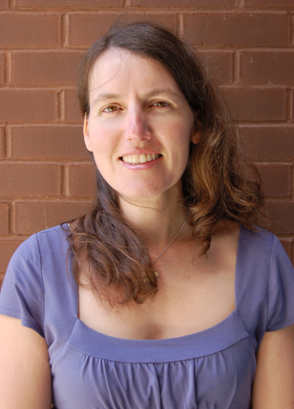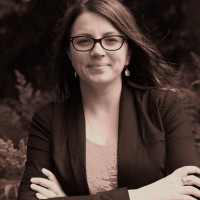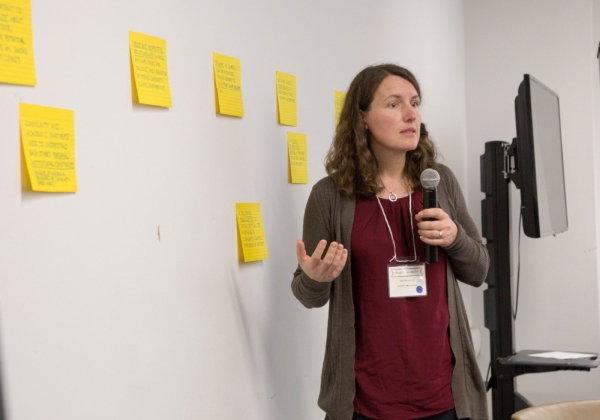 What is it like to receive funding to participate in community-campus engagement work?
What is it like to receive funding to participate in community-campus engagement work?
Magda Goemans and Anna Przednowek, two long-time CFICE research assistants, talk to CFICE about how continuous Community-Campus Engagement funding has impacted their experiences. Both speak to how continuous funding allowed them to immerse themselves in the community work, to make connections for future careers, and to strengthen their own activism.
That said, funding can sometimes be fraught with different tensions, like when they find themselves in a room with community partners who may not be getting compensated in the same way the RA’s are.
Listen to our podcast or read the transcript below for more!
Community-Campus Engagement Funding: A Student Perspective Podcast Transcript
Chelsea: Hello, and thank you for joining us. This is a Community First: Impacts of Community Engagement (CFICE) podcast. My name is Chelsea and I am really excited to introduce this series on Campus-Community Engagement Funding, where we sit down with people from community organizations, students, and administrators, to get their perspectives on the ins and outs of CCE funding.
It’s important to remember that it’s not just academics and community leaders involved in campus-community engagement. Students can often be the backbone of a community-campus partnership. Today we’re joined by two people who have worked with CFICE as students for a number of years. I’d like to welcome Magda Goemans and Anna Przednowek.
So, Magda, let’s start with you. I’m hoping you can tell me a bit about your roles with the CFICE project.
 Magda: So I’ve been an RA with CFICE for about 5 years now, and I’ve taken on two very different roles. So the first year I was an RA, I worked directly with a community partner within the Community Environmental Sustainability hub. It was a really amazing experience I had with that community partner; they were called Sustainable Living Ottawa East. They have been advocating for more sustainable measures in a redevelopment project occurring in their neighbourhood. So that gave me a lot of opportunities to learn about their work and hopefully assist with their work. And then the last two years, I’ve been working as an RA with the evaluation and analysis working group. Through that, we’ve had a really good opportunity to look at what we’ve learned from the first phase of CFICE and I’ve been helping along in gathering those learnings, analyzing, and hopefully putting out some useful outputs that have really helped us on different themes to better understand from our contexts.
Magda: So I’ve been an RA with CFICE for about 5 years now, and I’ve taken on two very different roles. So the first year I was an RA, I worked directly with a community partner within the Community Environmental Sustainability hub. It was a really amazing experience I had with that community partner; they were called Sustainable Living Ottawa East. They have been advocating for more sustainable measures in a redevelopment project occurring in their neighbourhood. So that gave me a lot of opportunities to learn about their work and hopefully assist with their work. And then the last two years, I’ve been working as an RA with the evaluation and analysis working group. Through that, we’ve had a really good opportunity to look at what we’ve learned from the first phase of CFICE and I’ve been helping along in gathering those learnings, analyzing, and hopefully putting out some useful outputs that have really helped us on different themes to better understand from our contexts.
Chelsea: Okay, and how about you Anna?
 Anna: So I have been involved with CFICE since 2015, for the first couple of years and still continuing now, I’m the coordinating research assistant for the Violence Against Women hub and working with Diana Majury the academic lead, and then some really amazing activists in the field of anti-Violence Against Women across Canada, and on demonstration projects with them. So more recently I have become the RA as well, transitioning into the Community Campus Engage Canada (CCEC) position, and here we’re looking at aligning the different institutions such as funders, non-government organizations, and academic institutions.
Anna: So I have been involved with CFICE since 2015, for the first couple of years and still continuing now, I’m the coordinating research assistant for the Violence Against Women hub and working with Diana Majury the academic lead, and then some really amazing activists in the field of anti-Violence Against Women across Canada, and on demonstration projects with them. So more recently I have become the RA as well, transitioning into the Community Campus Engage Canada (CCEC) position, and here we’re looking at aligning the different institutions such as funders, non-government organizations, and academic institutions.
Chelsea: Moving on to the topic of funding, I’m wondering what each of you have learned about campus-community engagement funding during your time with CFICE. So, back to you Magda.
Magda: Well I feel like I’ve learned a lot about funding, just from my own personal experience and through some of the work that we’ve been doing in terms of the analysis of our learnings from the first phase of CFICE. One of the big things I’ve found, which is so obvious, is that funding is so crucial to advancing community-campus engagement on so many levels and in so many different ways. Obviously as a student, I’ve been able to understand that from that perspective. I’ve also spent a lot of time as a student looking at the experiences of community partners, and from my vantage point, hopefully understanding a bit of their perspective as well. On this broader level, access or lack of access to funding, for CCE, that often reflects power relations between institutions and community members, faculty, students, that kind of thing. Ease of access to funding helps to demonstrate respect for community partners. We’ve seen that time and time again. Whereas in the opposite situation, where there are barriers to funding, administrative hurdles, if there’s just this huge time lag in terms of getting funding, that tends to…give the appearance of devaluing community research, which is of course the last thing institutions would want to do.
From my own perspective, I’ve found that longer term funding as well makes such an impact on communities and as a student, on students as well. That continuous funding, knowing it’s there for several years, has added such stability to my day-to-day work as a student, and as students we’re always balancing our schoolwork, our studies, potential teaching, other things going on, family life, and having that financial stability of an RAship has made a huge difference for me.
One other thing I’ll just mention is, going back to what I was just talking about in terms of funding being related to power and different opportunities. I have been aware of that, particularly in the first three years of my RAship, when I would sit in a room with community members, directly working with them, and I did have moments of discomfort, thinking, ‘I’m being paid for all the time I’m spending here, and the people around me are not necessarily receiving the resources that they need for administrative work, perhaps attending meetings, things like that.’ So that’s been my experience in general.
Chelsea: And what about you, Anna, do you have similar experiences in that way?
…our community partners felt like they were building capacity within their own communities and their own advocacy in communities through supporting students that had a similar agenda. They saw this as students taking on future work within their own communities.
Anna: Funding can be a benefit and a point of tension, as Magda had previously talked about. So in terms of the benefit, the projects that we had funded are probably projects that agencies typically wouldn’t have been able to fund themselves or wouldn’t be able to tackle in their every day front-line work, especially in the Violence Against Women [field] because some of the resources that agencies have are so stretched, so it’s been kind of a nice thing to be able to step in and contribute and support the work that community partners have been doing. But certainly a point of tension as Magda has mentioned as well, has been listening to some of our community partners and also evaluating some of the data that Magda had talked about in Community Campus Engagement and putting community needs first, is that for example research assistants might be getting paid more for doing their research assistant hours than community partners getting paid for doing their expertise level work as a community partner. So as a student, that’s been a huge learning curve and a huge point of learning for me, to have that ethical approach to Community Campus Engagement, especially when it comes to funding.
Certainly getting reimbursed is something that has been a point of tension as well, as Magda had alluded to. Being respectful to community partners and ensuring that they get reimbursed for participating and contributing their time and resources, etc., in a timely manner. I think the other piece I found that was really kind of exciting about us was our research assistants in the Violence Against Women hub have been predominantly handpicked by the community partners as well, so I thought that was a really interesting thing. Even though community partners didn’t hold the funding per se, they still had a choice and autonomy in choosing the people they wanted to work with which I think was really important. Quite often they were people who shared identity or shared ideas of activism, so that was something that was of great importance and of great interest as well.
And also, our community partners felt like they were building capacity within their own communities and their own advocacy in communities through supporting students that had a similar agenda. They saw this as students taking on future work within their own communities.
Chelsea: I think we’ve kind of touched on this a little bit, but I’m wondering, from the student perspective, what does CCE funding more broadly mean to you? What’s it’s significance?
Working in this kind of a community-campus partnership environment has definitely provided me not only with some new experiences, but with some connections to potentially future research or future career opportunities…
Magda: Well I have to say being funded as an RA and doing CCE work, this has been an incredible opportunity as a research assistant. I’ve literally gone beyond the office, beyond the classroom, and I believe I’ve had opportunities through this funding that I otherwise would not have had. Also, being an RA working in a CCE environment has exposed me to many people I would not have talked to otherwise. We know as students, particularly PhD students, we tend to go in our little caves, and work in isolation. Working in this kind of a community-campus partnership environment has definitely provided me not only with some new experiences, but with some connections to potentially future research or future career opportunities, etc. Just as I was mentioning before, that continuous funding has supported that. I’ve been able to maintain a momentum in my connections with people and a momentum on the projects I’m working on, without having to cut things short within short pieces of time.
Anna: I think similarly for me, it is the continuity and the opportunity to immerse myself in community-campus engagement. As a practicing social worker, I come from a community background, so it was actually really interesting for me to be on the academic side of this partnership, because typically I would be the community person who would be involved in these campus-community engagements. But one of the things funding certainly has provided is the opportunity to immerse myself, which I probably wouldn’t have had if I was working a full-time or part-time job off campus to fund myself through my education, and also trying to pick up and do the community-campus engagement as a volunteer or a side-on. I think what this has provided me with a really amazing opportunity to be able to immerse myself in that community and work more closely with both academic and community partners and getting to know the academic piece of it as well, which I think is really interesting for someone who’s interested in working in academia in the future. I also found this was a mentoring experience, that when I do end up working in academia, this was sort of like three years of mentoring experience that I got, of how to do better, how to do well, how to do a community-first Community Campus Engagement, which I think that part is invaluable. But I’m glad it came with funding.
Chelsea: That’s great, thank you both so much Magda and Anna. It was great to hear both of your perspectives. This has been a Community First: Impacts of Community Engagement (CFICE) on campus-community engagement funding. Please join us next time to hear from an administrative perspective on CCE funding. We’ll be hearing from Genevieve Harrison, the administrative guru with the CFICE project right here at Carleton.
Talk to you then!

